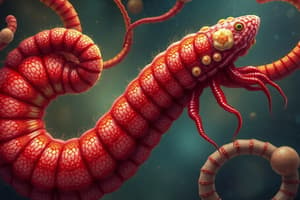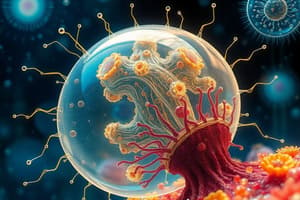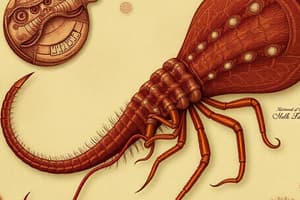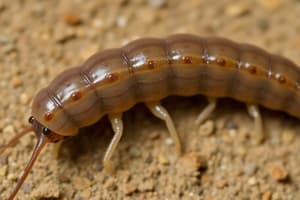Podcast
Questions and Answers
In Dipylidium caninum, what is the primary function of the uterus?
In Dipylidium caninum, what is the primary function of the uterus?
- To facilitate self-fertilization within the tapeworm.
- To digest nutrients absorbed by the tapeworm.
- To provide structural support to the tapeworm's body.
- To store and protect eggs before they are released. (correct)
Which reproductive strategy is employed by Dipylidium caninum?
Which reproductive strategy is employed by Dipylidium caninum?
- Cross-fertilization
- Parthenogenesis
- Asexual reproduction
- Self-fertilization (correct)
What is the state of most organs in Dipylidium caninum, besides the uterus?
What is the state of most organs in Dipylidium caninum, besides the uterus?
- Hypertrophied
- Atrophied (correct)
- Neoplastic
- Hyperplastic
How does the shape of the uterus change in Dipylidium caninum as it fills with eggs?
How does the shape of the uterus change in Dipylidium caninum as it fills with eggs?
What adaptation allows Dipylidium caninum to prioritize reproduction, even if other organ systems are not functioning optimally?
What adaptation allows Dipylidium caninum to prioritize reproduction, even if other organ systems are not functioning optimally?
How does a human become infected with the adult stage of Taenia saginata?
How does a human become infected with the adult stage of Taenia saginata?
What role does a human play in the life cycle of Taenia solium when infected with cysticercosis?
What role does a human play in the life cycle of Taenia solium when infected with cysticercosis?
In platyhelminthes, what is the primary function of the cirrus organ?
In platyhelminthes, what is the primary function of the cirrus organ?
What is the correct term for the larval stage of Taenia solium that causes cysticercosis in humans?
What is the correct term for the larval stage of Taenia solium that causes cysticercosis in humans?
In which scenario would a human be considered the definitive host for a cestode?
In which scenario would a human be considered the definitive host for a cestode?
Which of the following accurately describes the arrangement of the testes in platyhelminthes?
Which of the following accurately describes the arrangement of the testes in platyhelminthes?
What is the role of the ootype in the reproductive system of platyhelminthes?
What is the role of the ootype in the reproductive system of platyhelminthes?
Which of the following best describes the relationship between Taenia solium and cysticercosis?
Which of the following best describes the relationship between Taenia solium and cysticercosis?
Which sequence accurately describes the pathway of sperm in male platyhelminthes, starting from the testes?
Which sequence accurately describes the pathway of sperm in male platyhelminthes, starting from the testes?
What is the function of the common vitelline duct in female platyhelminthes reproductive system?
What is the function of the common vitelline duct in female platyhelminthes reproductive system?
What is the primary function of the chemicals secreted by certain worms to prevent digestion by their host?
What is the primary function of the chemicals secreted by certain worms to prevent digestion by their host?
A researcher discovers a new species of parasitic worm. Initial analysis shows it secretes a compound that inhibits protease activity in its host. What is the most likely benefit of this compound to the worm?
A researcher discovers a new species of parasitic worm. Initial analysis shows it secretes a compound that inhibits protease activity in its host. What is the most likely benefit of this compound to the worm?
What is the primary characteristic of the anterior end of an adult cestode (tapeworm)?
What is the primary characteristic of the anterior end of an adult cestode (tapeworm)?
An adult tapeworm's body is divided into distinct sections. Which of the following accurately describes this segmentation?
An adult tapeworm's body is divided into distinct sections. Which of the following accurately describes this segmentation?
How does the variable shape of a cestode's anterior end, equipped with attachment organs, contribute to its parasitic lifestyle?
How does the variable shape of a cestode's anterior end, equipped with attachment organs, contribute to its parasitic lifestyle?
Which larval stage of a cestode parasite typically develops within an intermediate host after ingestion of eggs?
Which larval stage of a cestode parasite typically develops within an intermediate host after ingestion of eggs?
A veterinarian diagnoses a dog with a tapeworm infection after observing proglottids in its feces. Which larval stage is most likely to be found in the intermediate host that the dog ingested?
A veterinarian diagnoses a dog with a tapeworm infection after observing proglottids in its feces. Which larval stage is most likely to be found in the intermediate host that the dog ingested?
In which larval stage does asexual reproduction via budding occur, leading to the formation of numerous protoscolices within a large fluid-filled structure?
In which larval stage does asexual reproduction via budding occur, leading to the formation of numerous protoscolices within a large fluid-filled structure?
A hydatid cyst is discovered during a scan of a sheep's liver. What is the significance of this finding in terms of the parasite's life cycle?
A hydatid cyst is discovered during a scan of a sheep's liver. What is the significance of this finding in terms of the parasite's life cycle?
A freshwater fish is found to contain a larval cestode. Upon examination, the larva is solid and elongated, lacking a bladder. Which larval stage is this most likely to be?
A freshwater fish is found to contain a larval cestode. Upon examination, the larva is solid and elongated, lacking a bladder. Which larval stage is this most likely to be?
Which mechanism explains how Diphyllobothrium latum causes pathogenic lesions in its host?
Which mechanism explains how Diphyllobothrium latum causes pathogenic lesions in its host?
Hymenolepis nana induces pathogenic effects through which of the following mechanisms?
Hymenolepis nana induces pathogenic effects through which of the following mechanisms?
What pathological process is directly associated with Taenia saginata within the host's intestinal tract?
What pathological process is directly associated with Taenia saginata within the host's intestinal tract?
If a patient is diagnosed with a parasitic infection leading to vitamin B12 deficiency, which parasite is the most likely cause?
If a patient is diagnosed with a parasitic infection leading to vitamin B12 deficiency, which parasite is the most likely cause?
A patient presents with symptoms of intestinal distress and inflammation, but without signs of mechanical blockage. Which parasite is most likely responsible?
A patient presents with symptoms of intestinal distress and inflammation, but without signs of mechanical blockage. Which parasite is most likely responsible?
Why is Hymenolepis nana unique among cestodes regarding its life cycle?
Why is Hymenolepis nana unique among cestodes regarding its life cycle?
Considering its life cycle, how would you classify a human infected with Hymenolepis nana?
Considering its life cycle, how would you classify a human infected with Hymenolepis nana?
Which characteristic of Hymenolepis nana is responsible for its ability to complete its lifecycle in a single host?
Which characteristic of Hymenolepis nana is responsible for its ability to complete its lifecycle in a single host?
What is a potential consequence of Hymenolepis nana's ability to complete its life cycle in a single host?
What is a potential consequence of Hymenolepis nana's ability to complete its life cycle in a single host?
How might the typical two-host life cycle of cestodes influence their transmission dynamics, compared to Hymenolepis nana?
How might the typical two-host life cycle of cestodes influence their transmission dynamics, compared to Hymenolepis nana?
How does the presence of multiple central nerve ganglia near the scolex in cestodes influence their survival strategy?
How does the presence of multiple central nerve ganglia near the scolex in cestodes influence their survival strategy?
What is the most significant implication of nutrient absorption occurring directly through the tegument of cestodes?
What is the most significant implication of nutrient absorption occurring directly through the tegument of cestodes?
How does the cestode's tegument contribute to its survival within a host's digestive system, beyond nutrient absorption?
How does the cestode's tegument contribute to its survival within a host's digestive system, beyond nutrient absorption?
How does Echinococcus granulosus primarily induce pathogenic effects in its intermediate host?
How does Echinococcus granulosus primarily induce pathogenic effects in its intermediate host?
If a cestode's tegument is damaged, what is the most likely immediate consequence for the parasite?
If a cestode's tegument is damaged, what is the most likely immediate consequence for the parasite?
Considering both the nervous system and tegument, how do these features collectively maximize a cestode's parasitic efficiency?
Considering both the nervous system and tegument, how do these features collectively maximize a cestode's parasitic efficiency?
What is the primary significance of the protoscolices found within the hydatid cyst of Echinococcus granulosus?
What is the primary significance of the protoscolices found within the hydatid cyst of Echinococcus granulosus?
Which of the following correctly describes the role of the intermediate host in the life cycle of Echinococcus granulosus?
Which of the following correctly describes the role of the intermediate host in the life cycle of Echinococcus granulosus?
How does Hymenolepis nana bypass the requirement for an intermediate host, unlike many other cestodes?
How does Hymenolepis nana bypass the requirement for an intermediate host, unlike many other cestodes?
What environmental condition is crucial for the maturation and hatching of Hymenolepis nana eggs after they are released into the environment?
What environmental condition is crucial for the maturation and hatching of Hymenolepis nana eggs after they are released into the environment?
Which of the following cestodes is associated with the cysticercus larval stage?
Which of the following cestodes is associated with the cysticercus larval stage?
Which of the following tapeworms is least likely to cause significant pathogenic effects directly from the adult worm stage in the intestinal tract?
Which of the following tapeworms is least likely to cause significant pathogenic effects directly from the adult worm stage in the intestinal tract?
Which of the following larval stages is characterized by the presence of multiple protoscolices formed asexually within a large, fluid-filled structure?
Which of the following larval stages is characterized by the presence of multiple protoscolices formed asexually within a large, fluid-filled structure?
A patient is diagnosed with sparganosis. Which parasite is most likely responsible for this condition?
A patient is diagnosed with sparganosis. Which parasite is most likely responsible for this condition?
In which scenario would a human be considered an intermediate host for a cestode?
In which scenario would a human be considered an intermediate host for a cestode?
What is the key characteristic of Diphyllobothrium latum eggs that differentiates them from those of some other tapeworm species?
What is the key characteristic of Diphyllobothrium latum eggs that differentiates them from those of some other tapeworm species?
How does the consumption of undercooked fish contribute to the pathogenesis of tapeworm infections in humans and fish-eating animals?
How does the consumption of undercooked fish contribute to the pathogenesis of tapeworm infections in humans and fish-eating animals?
What is the significance of the hexacanth embryo found within the eggs of certain tapeworms like Diphyllobothrium latum?
What is the significance of the hexacanth embryo found within the eggs of certain tapeworms like Diphyllobothrium latum?
Why is the infective stage of Diphyllobothrium latum found in undercooked fish a significant concern for public health?
Why is the infective stage of Diphyllobothrium latum found in undercooked fish a significant concern for public health?
How does the life cycle strategy of Diphyllobothrium latum, involving both aquatic and terrestrial hosts, increase its chances of successful transmission?
How does the life cycle strategy of Diphyllobothrium latum, involving both aquatic and terrestrial hosts, increase its chances of successful transmission?
In diagnosing parasitic infections, what is a key limitation of relying solely on radio-imaging techniques?
In diagnosing parasitic infections, what is a key limitation of relying solely on radio-imaging techniques?
When is a tissue biopsy most critical in diagnosing parasitic infections, compared to other methods?
When is a tissue biopsy most critical in diagnosing parasitic infections, compared to other methods?
How do immuno-diagnostic techniques primarily aid in the detection of parasitic infections?
How do immuno-diagnostic techniques primarily aid in the detection of parasitic infections?
A patient presents with clinical signs suggestive of a parasitic infection, but initial radio-imaging results are inconclusive. Which subsequent diagnostic approach would provide the most definitive diagnosis?
A patient presents with clinical signs suggestive of a parasitic infection, but initial radio-imaging results are inconclusive. Which subsequent diagnostic approach would provide the most definitive diagnosis?
In which scenario would immuno-diagnostic techniques be LEAST reliable for detecting a parasitic infection?
In which scenario would immuno-diagnostic techniques be LEAST reliable for detecting a parasitic infection?
Flashcards
Adult Cestodes
Adult Cestodes
Tapeworms that infect humans at their adult stage, making humans the definitive host.
Larval Cestodes
Larval Cestodes
Tapeworms that infect humans at their larval stage, making humans the intermediate host.
Taenia saginata
Taenia saginata
A type of tapeworm with humans as definitive hosts.
Cysticercus cellulosae
Cysticercus cellulosae
Signup and view all the flashcards
Cysticercosis
Cysticercosis
Signup and view all the flashcards
Dipylidium caninum
Dipylidium caninum
Signup and view all the flashcards
Atrophy
Atrophy
Signup and view all the flashcards
Self-fertilization
Self-fertilization
Signup and view all the flashcards
Uterus
Uterus
Signup and view all the flashcards
Uterus (in Dipylidium)
Uterus (in Dipylidium)
Signup and view all the flashcards
Worm's defense mechanism
Worm's defense mechanism
Signup and view all the flashcards
Cestode anatomy
Cestode anatomy
Signup and view all the flashcards
Cestode scolex
Cestode scolex
Signup and view all the flashcards
Attachment organs
Attachment organs
Signup and view all the flashcards
Parasite's anchor
Parasite's anchor
Signup and view all the flashcards
Testes Arrangement
Testes Arrangement
Signup and view all the flashcards
Vasa Efferentia Function
Vasa Efferentia Function
Signup and view all the flashcards
Vas Deferens Role
Vas Deferens Role
Signup and view all the flashcards
Seminal Vesicle Purpose
Seminal Vesicle Purpose
Signup and view all the flashcards
Female Reproductive Path
Female Reproductive Path
Signup and view all the flashcards
Procercoid
Procercoid
Signup and view all the flashcards
Plerocercoid
Plerocercoid
Signup and view all the flashcards
Cysticercus
Cysticercus
Signup and view all the flashcards
Coenurus
Coenurus
Signup and view all the flashcards
Hydatid
Hydatid
Signup and view all the flashcards
Nutrient Competition
Nutrient Competition
Signup and view all the flashcards
Intestinal Inflammation
Intestinal Inflammation
Signup and view all the flashcards
Intestinal Obstruction
Intestinal Obstruction
Signup and view all the flashcards
Taenia saginata: Obstruction
Taenia saginata: Obstruction
Signup and view all the flashcards
Diphyllobothrium latum
Diphyllobothrium latum
Signup and view all the flashcards
Cestode Nerve Ganglia
Cestode Nerve Ganglia
Signup and view all the flashcards
Tegument Function
Tegument Function
Signup and view all the flashcards
Cestode Nutrient Uptake
Cestode Nutrient Uptake
Signup and view all the flashcards
Tegument Makeup
Tegument Makeup
Signup and view all the flashcards
Scolex and Ganglia
Scolex and Ganglia
Signup and view all the flashcards
Definitive Host
Definitive Host
Signup and view all the flashcards
Intermediate Host
Intermediate Host
Signup and view all the flashcards
Typical Cestode Life Cycle
Typical Cestode Life Cycle
Signup and view all the flashcards
Hymenolepis nana Unique Life Cycle
Hymenolepis nana Unique Life Cycle
Signup and view all the flashcards
H. nana Host Roles
H. nana Host Roles
Signup and view all the flashcards
Echinococcus granulosus
Echinococcus granulosus
Signup and view all the flashcards
Hymenolepis nana eggs
Hymenolepis nana eggs
Signup and view all the flashcards
Coracidium liberation
Coracidium liberation
Signup and view all the flashcards
Mature egg of H. nana
Mature egg of H. nana
Signup and view all the flashcards
Coracidium
Coracidium
Signup and view all the flashcards
Fish Tapeworm Infection
Fish Tapeworm Infection
Signup and view all the flashcards
Infective Stage
Infective Stage
Signup and view all the flashcards
Host
Host
Signup and view all the flashcards
Tapeworm Eggs
Tapeworm Eggs
Signup and view all the flashcards
Non-operculated Eggs
Non-operculated Eggs
Signup and view all the flashcards
Radio-imaging
Radio-imaging
Signup and view all the flashcards
Tissue biopsy
Tissue biopsy
Signup and view all the flashcards
Immuno-diagnostic techniques
Immuno-diagnostic techniques
Signup and view all the flashcards
Taenia solium
Taenia solium
Signup and view all the flashcards
Tapeworm Pathogenicity
Tapeworm Pathogenicity
Signup and view all the flashcards
Study Notes
- Cestoda are long, segmented, tape-like worms.
- They are endoparasitic, and adults inhabit the small intestine of a definitive host.
- Some cestodes invade human tissue during their larval stages, forming tissue tapeworms.
Classification
- Order Pseudophyllidea includes:
- Diphyllobothrium mansoni (Spirometra mansoni)
- Diphyllobothrium latum
- Diphyllobothrium proliferum
- Order Cyclophyllidea includes:
- T. solium
- Taenia saginata
- T. multiceps
- Echinococcus granulosus
- E. multilocularis
- Hymenolepis nana
- Dipylidium caninum
- H. diminuta
Mode of Infection
- Humans can be infected by adult tapeworms or larval stages.
Intestinal Cestodes Infections
- Human infection occurs in the definitive host with adult cestodes.
- These includes:
- Taenia saginata
- Taenia solium
- Hymenolepis nana
- Hymenolepis diminuta
- Diphyllobothrium latum
- Dipylidium caninum
Extra-Intestinal or Tissue Cestodes
- Human infection occurs in the intermediate host with larval cestodes
- These include:
- Cysticercus cellulosa of Taenia solium (Cysticercosis)
- Coenurus cyst of Multiceps multiceps (Coenurosis)
- Sparganum or plerocercoid larva of Diphyllobothrium mansoni or D. proliferum (Sparganosis)
- Hydatid cyst of Echinococcus granulosus or E. multilocularis (Hydatid disease)
- Cysticercoid larva of Hymenolepis nana
General characteristics
- Cestodes are flattened dorso-ventrally and vary in length from a few millimeters to several meters.
- They lack a body cavity and a digestive system.
- Nutrition occurs via absorption of nutritive materials from the surrounding medium through the body wall.
- The excretory system includes multiple flame cells, collecting tubules, and 4 longitudinal excretory ducts (2 dorsal and 2 ventral) that run laterally and open into a bladder in the last segment.
- They have a nervous system with multiple central nerve ganglia in the scolex region.
- The tegument absorbs nutrients through the body wall.
- It has a protective function.
- It secretes chemicals to prevent worm digestion.
Morphology
- Adult worms are divided into three parts: scolex, neck, and strobila
- The scolex has variable shapes and organs of attachment such as bothria or suckers to hold the tapeworm in place.
- There are two main types of holdfast organs:
- Suckers are typically 4 cup-shaped muscular suckers, or 4 cup-shaped muscular suckers with a rostellum armed with rings of hooks.
- Bothria are two elongated shallow grooves or pits.
- The neck is the region of growth.
- The strobila consists of segments classified according to the degree of maturity of their genital organs: immature, mature, and gravid segments.
Types of Segments
Immature Segment
- Located near the neck.
- Genital organs are not yet differentiated.
Mature Segment
- They are Hermaphroditic, having single or paired male and female genital systems, such as in Dipylidium caninum.
- Reproduction can occur through self-fertilization (within a single segment) or cross-fertilization (between different segments).
Gravid Segment
- Contains:
- a posterior part of the parasite, except in Pseudophyllidean parasites.
- atrophied organs except for the uterus, which is filled with eggs and varies in shape.
- Gravid segments are either separated and passed with stool actively or passively.
Male Genital System
- Consists of multiple testes throughout the dorsal surface of the segment.
- Consists of :
- vasa efferentia
- vas deferens
- seminal vesicle
- ejaculatory duct
- cirrus organ surrounded by the cirrus sac that opens in the common genital pore.
- Some cestodes, like Hymenolepis species, have only 3 testes in each mature segment.
- The common genital pore is present on the mid-ventral surface in Pseudophyllidean parasites or on the lateral borders in Cyclophyllidean parasites.
Female Genital System
- Located on the ventral surface of segments.
- It consists of a bi- or trilobed ovary that connects to the oviduct and unites with the common vitelline duct at the ootype.
- Cyclophyllidea have a blind tube uterus.
- Pseudophyllidea uterine opens to the outside at ventral surface.
- Cyclophyllidea: Packed mass-like situated behind the ovary.
- Pseudophyllidea contain multiple vitelline follicles scattered in each segment.
Life cycle
- The life cycle is completed in 2 different hosts, definitive and intermediate
- Adult tapeworms live the small intestine of definitive hosts.
- Cestodes need two hosts (definitive and intermediate) to complete their life cycles.
- An exception is Hymenolepis nana, which can complete its life cycle in only one host.
- Sometimes, humans can act as an intermediate host and harbor cestode larvae in different organs.
Diphyllobothrium mansoni (Sparganosis)
- Taenia solium (cysticercosis) or Taenia multiceps (coenurosis)
- Echinococcus granulosus (hydatid disease)
- Hymenolepis nana
- Pseudophyllidean tapeworms have operculated, immature eggs (diagnostic stage).
- After maturation, eggs hatch releasing coracidium needing fresh water.
- The coracidium is infective for the first intermediate host Cyclops where it changes to procercoid.
- When Cyclops is ingested by fish, the procercoid develops into the plerocercoid (infective stage)..
- Humans and fish-eating animals are infected when they eat undercooked fish with plerocercoid.
- Cyclophyllidean tapeworms have non-operculated, mature eggs with hexacanth (6-hooked) embryos.
- When the eggs are ingested by the intermediate host, onchospheres are freed, penetrate the intestinal wall, enter the circulation, and develop into larval stages.
- Definitive hosts become infected upon ingestion of the larval stages in different organs and tissues.
Differences Between Pseudophyllidea and Cyclophyllidea
Scolex
- Pseudophyllidea: Elongated and has Bothria
- Cyclophyllidea: Globular and has suckers and hooks
Mature Segment
- Genital pore:
- Pseudophyllidea: Ventral and open ventrally
- Cyclophyllidea: Lateral and Blind
- The uterus
- Pseudophyllidea: Scattered
- Cyclophyllidea: Single mass
- The vitellaria
- Pseudophyllidea: Absent
- Cyclophyllidea: Present
- Gravid Segment:
- Pseudophyllidea: Operculated
- Cyclophyllidea: Non-operculated
Eggs
- Pseudophyllidea: Immature and needs water for development.
- Cyclophyllidea: Mature and don't need water.
Intermediate Hosts
- Pseudopphyllidea has Two hosts
- Cyclopphyllidea has One host
Larval Stages
- Pseudophyllidea has solid larvae: Procercoid and Plerocercoid
- Cyclophyllidea has Cystic larvae: Cysticercus, Coenurus, Hydatid, and Cysticercoid
Members
- Pseudophyllidea: Diphyllobothrium latum, Diphyllobothrium mansoni, Diphyllobothrium proliferum.
- Cyclophyllidea: Taenia saginata, Taenia solium, Teania multiceps, Echinococcus granulosus, Echinococcus multilocularis, Hymenolepis nana, Hymenolepis diminuta, Dipylidium caninum.
Pathogenicity
- The pathogenicity in tapeworms comes from adults and larvae.
- Pathogenic lesions are caused:
- Competing with the host for nutrients such as vitamin B12 (e.g., D. latum).
- Local intestinal inflammatory reactions (e.g., Hymenolepis nana).
- Mechanical intestinal obstruction (e.g., Taenia saginata).
- Migration to different organs and tissues with pressure effects (e.g., Diphyllobothrium mansoni (sparganosis), Taenia solium (cysticercosis), and Echinococcus granulosus (hydatid disease)).
Clinical Picture
- Most tapeworm infections are asymptomatic
- Heavy infections may cause symptoms.
- Larval infections (extra-intestinal) are more serious.
- Clinical presentation depends on the number, size, and location of tissue larvae.
Diagnosis
- Diagnosis of intestinal tapeworm infections is by stool examination
- Diagnosis of extra-intestinal infections is by:
- Radio-imaging
- Tissue biopsy
- Immuno-diagnostic techniques.
Studying That Suits You
Use AI to generate personalized quizzes and flashcards to suit your learning preferences.





